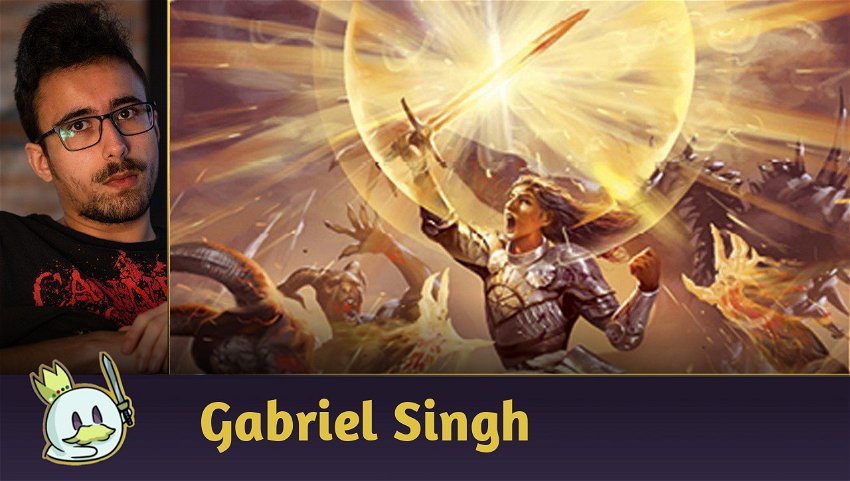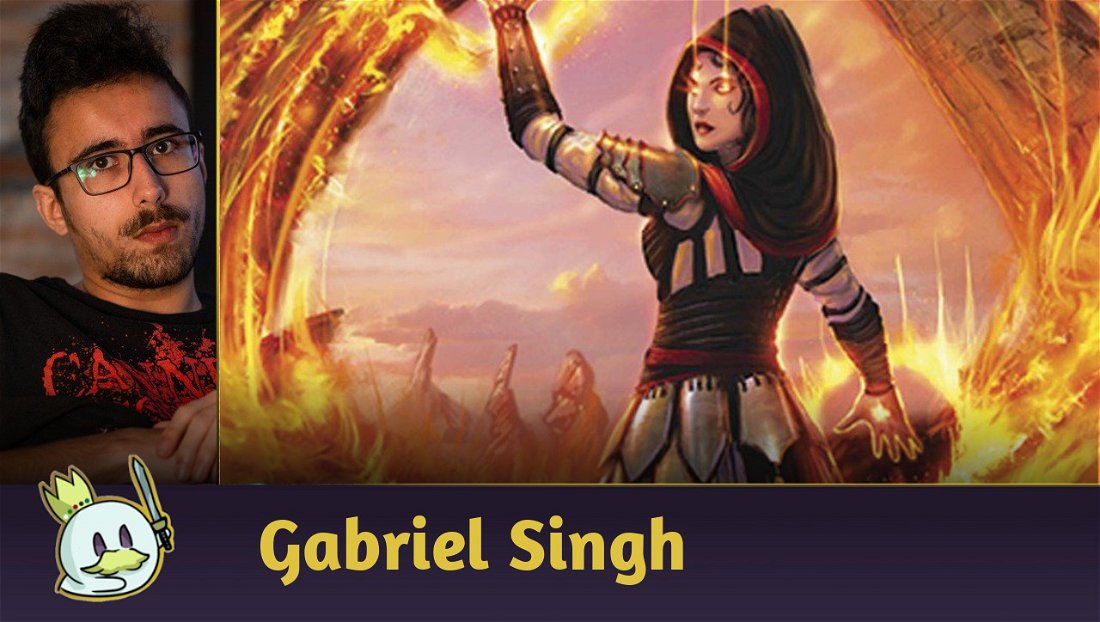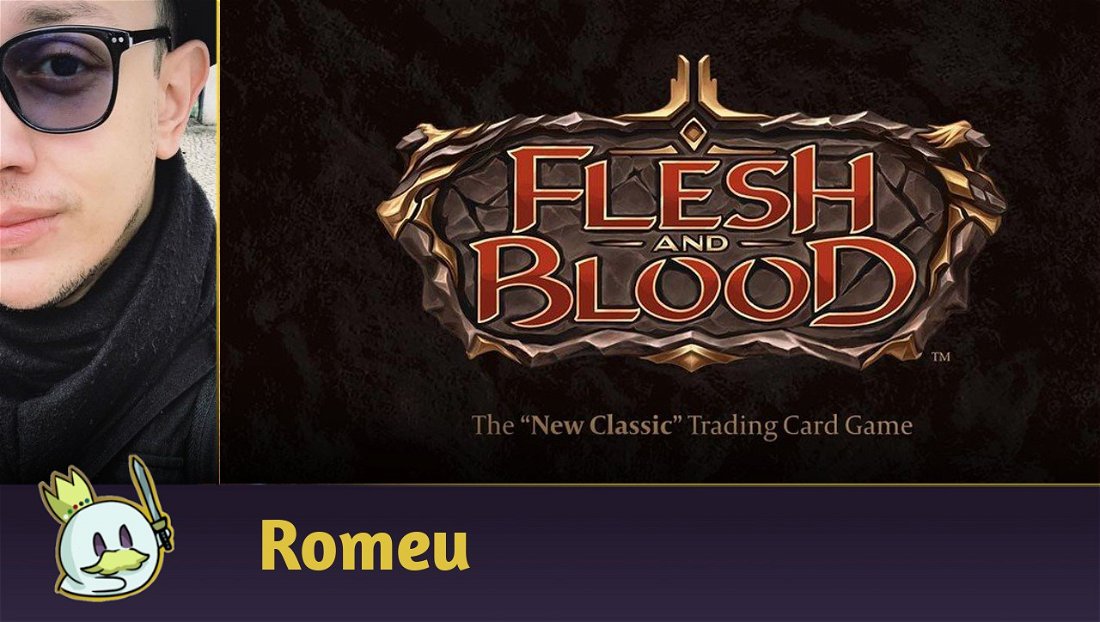What is this series for?
Something I'm often asked by people who know Flesh and Blood in one way or another is:
“Which Hero is the most [INSERT ADJECTIVE HERE]?”
- People
And, of course, depending on the adjective chosen and what I know of the person, the answer varies. This article is an attempt to show you a little bit about each Hero in Flesh and Blood: a bit about their lore, their general playstyle, some key cards and a bit of what you'll do during a turn with them when you're playing.
I split the article into two parts, with the first one you are now reading talking about all the Brutes, Guardians, Illusionists, Mechanologists and Merchants in the game. So without further ado, let's briefly comment on the rules of Blitz, which is the introductory format to the game - and I recommend that everyone plays when they first start playing FaB.
The Rules of the Blitz Format
Flesh and Blood, as well as other TCGs, has different game formats, Blitz being one of them. Formats are a way to bring different experiences to players, and each one has different attractive factors to play with.
In Blitz, only Heroes with the Young subtype can be played. Most “adult” heroes in Flesh and Blood have the Young variation, but some Young heroes lack an adult counterpart. This means that Blitz's pool of heroes is larger than other formats like Classic Constructed, which is the competitive format of the game.
The differences between Blitz and Classic Constructed are limited to deckbuilding restrictions and hero choice, therefore. In practice, this difference translates into a different gameplay in each of them: Classic Constructed is more methodical, with matches taking up to 50 minutes (with an average of 30min, in my experience), while in Blitz, the matches are shorter, lasting up to 30 minutes with an average of 10-15min.
Going now to the rules, a Blitz deck is made up of:
- 1 Young Subtype Hero.
- Up to 11 equipment and weapon cards. After seeing your opponent's hero, you will be able to choose which equipment to use in the match.
- A deck of 40 cards.
The Blitz Heroes
Each Flesh and Blood hero has specific mechanics used to win. At the end of the day, everyone wants to drop the opponent to 0 life, but the road to get there is different for each of them.
Let's look at all the cool heroes in Blitz, broken down by class, with a brief description of the hero, their archetype, and their most common play patterns, as well as some key cards to keep an eye out for.
Brute
The Brute class in Flesh and Blood has as its main identity the idea that "not everything is under your control, including you."

With additional random discard costs, giant attacks that depend on whether your opponent blocks or not, and completely change your turn, equipment like Scabskin Leathers and Skull Crushers, Brutes are explosive and unpredictable.
Kayo

Kayo, Berserker Runt is the roughest Brute in Flesh and Blood. Kayo came to the game on the Crucible of War set, ushering in the creation of Young heroes without an adult version. Tattooing ”Go Hard or Go Home on his back, from the name you can see why he's in the game: K.O.. The hero is generally considered a meme, but that never stopped anyone from playing with him.

Kayo kills and dies for the dice. Like I said, he's a meme hero, so you better make a good meme. The deck usually uses cards with Intimidate like the Brute staple Barraging Beatdown (1) and big attacks to try to kill in one hit, as long as the RNG is on your side.
A common Kayo turn involves blocking while you try to make attacks with your weapon, and setting up a big turn with Ready to Roll and Bloodrush Bellow to make an attack that, if all goes well, the opponent won't be able to bear. Try using your Gambler's Gloves to attempt to save the attack at the right time, and again, good luck.
Levia

Levia is a Shadow Brute with a sad history of parental abandonment through murder by her captor, Lady Barthimont. Levia had her revenge, however, by killing her and making a promise: servitude never again.

Shadow Heroes have access to cards with Blood Debt, which means...
“At the beginning of your end phase, if this card is in your banished zone, lose 1
- Blood Debt
Having Blood Debt might seem like a downside, and in fact, it often is. But some cards like Deep Rooted Evil and Ghostly Visit (1) turn this into a good thing, and Levia's ability itself is a way to temporarily turn off Blood Debt.
As a Brute, Levia also has the identity of strong attacks. Cards like Endless Maw (1) and Graveling Growl (1) are extremely powerful for their cost, the only condition is to banish 3 random cards from your Graveyard as an additional cost. If all goes well, even if you banish cards with Blood Debt, you'll also banish one of her many attacks with 6
A regular Levia turn involves blocking with two cards and making a large attack that preferably places a 6
A strong Levia turn usually includes some Go Again, attack like Dread Screamer (1) followed by a Graveling Growl (1), or turns where the power of Bloodrush Bellow and its claws Mandible Claw attack for 5
Rhinar

Rhinar is the classic crazy barbarian. There's no conversation, no planning, just beating. His lore is as elaborate and rich as that of your first D&D character: he came from nothing, raised by wolves, and now he lives by kicking ass.

Rhinar, the original Brute, has a specialty: big attacks and no on-hit effects, which means they are “easy” to block, as letting 1 or 2 damage go by means nothing else.
To counter this “weakness” the Rhinar has the Intimidate ability, which reads
“Target hero banishes face down a random card from their hand. At the beginning of the end phase, return all cards banished this way to their owner's hand.”
- Intimidate
With this, Rhinar makes it difficult for the opponent to block, as they won't have full control of how to defend. Rhinar is more comfortable in a “Traditional Flesh and Blood” game, in which both players defend a bit and attack a bit.
A common Rhinar turn involves blocking a bit and using his club, Romping Club alone or with a Barraging Beatdown (2) until he has a good opening for his big turns.
A strong turn with Rhinar involves putting together several Barraging Beatdown (1) and attacking with a Pack Hunt (1) or a Swing Big and your opponent only accepts defeat because has no hand to defend a giant attack. Using your Scabskin Leathers well is an important part of the hero, but it's often a mistake to activate it to turn an already good turn into a huge turn because of the chance you'll just pass the turn and probably lose the game.
Guardian
Flesh and Blood Guardians are protectors of their realms. In battle, Guardians use powerful attacks that are full of energy and, if left unguarded, can leave permanent marks on their victims.

With strong defenses on cards like Staunch Response (1), their high-cost and good defense cards make them able to adapt their fighting styles as the situation demands, punishing misplays with insurmountable forces.
Bravo

Bravo is everyone's darling. Everfest's Carnival star, the "Strongest Man in Rathe", Bravo is the classic Hero, treating his battles as performances to be watched and revered, the hunky man truly puts on a show wherever he goes.

An important part of his style is his use of Seismic Surge tokens, created by his legendary armor Tectonic Plating. Surges serve as a mini-resource bank: spend 1

To be a good Bravo, you need to be prepared to adapt to what happens at the board. That means giving up your hand to defend a strong turn while keeping a blue card to hit with Anothos every now and then. As much as the urge to attack is strong, waiting for an opening and lining up unstoppable turns with strong on-hit effects from your Crush attacks are key to be a good Bravo.
A typical Bravo turn includes defending with part of your hand while you develop an Aura like Blessing of Deliverance (1) or Show Time! and make a Seismic Surge with your Tectonic Plating.
A strong turn with Bravo better occurs when some set up was done on your previous turn. Often having the effect of an active Surge can be the difference between activating your hero ability and giving Dominate for an attack or not, or maybe even being able to use a Pummel (1) on one of his giant slaps.
Oldhim

Oldhim, even when he was young, was already old. Flesh and Blood's Santa Claus is older than civilization, and helped defend Rathe from the Old Ones. After a calamity, Oldhim fell into a deep icy slumber, recently waking up believing that great evil will come to Rathe, and when that happens, there will be Oldhim.

Its lore and ability of the card itself already indicate what Oldhim wants to do: defend. With his Essence of Earth and Ice Oldhim has access to the pure attack and defense efficiency of Earth and the disruptive ability of Ice, a powerful combination for those who battle the old man.
Like other heroes in the Tales of Aria set, the Elemental Guardian has Ice and Earth Fusion on many of its cards, which reads:
“As an additional cost to play this card, you may reveal an ELEMENT card from your hand”
- ELEMENT Fusion
Oldhim's battle style is the traditional Guardian: adaptable. A good Oldhim, however, must recognize openings given by the opponent and punish them accordingly, either with his big attacks or with the pressure given by the Frostbite tokens created by his Winter's Wail.
One extremely important piece of equipment Oldhim has access to thanks to his Essence of Earth is the Crown of Seeds, one of those pieces of equipment that it's easy to underestimate the importance of when we start. The ability to prevent 1 damage while your arsenal is cycled, fixing your hands in the future, is pretty strong on its own, and paired with Rampart of the Ram's Head, represents at least 2 blocks per zero cards of your deck.
A typical Oldhim turn involves activating his Crown of Seeds and blocking with his shield and 1-2 cards, either directly or through activating the hero's own Defense Reaction. On your turn, you come back with Winter's Wail and make an Arsenal, starting all over again.
A strong Oldhim turn is difficult to show explicitly, as the hero's playstyle is to win turns for sheer efficiency, slow and methodical. That said, turns where you can pitch your Pulse of Isenloft as a block 2 + disruption activating Oldhim (pulse counts as both elements after all) and manage to hit with one of your attacks with disruption, such as an Endless Winter or a Command and Conquer, will take you far in the match, making the game increasingly difficult for the opponent to stay ahead by sheer efficiency of your plays.
Valda Brightaxe

Valda Brightaxe was found as a child outside one of the most famous taverns in Korshem, Crossroad of Elements. Raised by the tavern keeper, Valda was too impatient to follow the brewery's path, but she found a natural talent for "environmental safety".

Valda does well when she manages to activate her ability, obviously, and for that, it's important to maximize the use of her Earthlore Bounty, using auras that draw cards like Blessing of Deliverance (1) with Embolden (3) and This Round's on Me. Making multiple Seismic Surge and attacking with "free" Dominate and free attacks, Valda can put pressure on opponents like no other hero.
A common turn for Valda will include drawing some cards or using a Seismic Stir (1) while attacking with her Anothos for 6
A strong turn with Valda naturally includes a big Crush attack that you play for free. This means you can use every other card in your hand to block and still beat your opponent with a free Mangle. This playstyle is different from other heroes in that you don't need many cards during your pressure turn; instead, you need many cards for your setup turn.
Illusionist
Illusionists are masters of confusion and distraction. Well-versed in redirection, illusionists utilize great mirages and create distractions for their opponents, distractions that -- if ignored for too long -- become a nightmare.

In play, illusionists have two complementary identities, using attacks with Phantasm and Auras with Spectra, which read:
“When this attack is defended by a non-Illusionist attack action card with 6 or more 
- Phantasm
“Passing Mirage can be attacked. When Passing Mirage becomes the target of an attack, destroy it and close the combat chain. The attack does not resolve.”
- Spectra
So far, there is only one Illusionist in Flesh and Blood, Prism, who is also a Light Hero, having access to Light type cards in addition to the purely Illusionist pieces.
Prism

As a child, Prism didn't remember anything about her past when she was found by a Master of Light. With a talent for reading, Prism studied for years at the Great Library of Solana, where she honed, with dedication, her natural ability to bring the Heralds of ancient times to reality to fight the enemies of Sol.

Prism's game is not the same as other heroes. Her Light Illusionist Auras, such as Ode to Wrath and Parable of Humility serve as a way to absorb an opponent's attack and, on your turn, attack them directly via your Luminaris weapon. Her Heralds like Herald of Protection (2) and Herald of Triumph (1) fill your Soul, which can then be used to create multiple Spectral Shield using your hero's ability.
For Prism it's hard to find a common turn because often your deck has two modus operandis depending on your choice of decks or even in the same deck, depending on your hand. Block a bit while attacking with a Herald of Triumph (2) or use your health as a resource to resolve attacking Auras (due to Luminaris) such as Merciful Retribution and Haze Bending .
A strong Prism turn can involve her legendary cloak Vestige of Sol generating resources after a card goes to her Soul (through one of her Heralds connecting with the opponent, or the activation of a Halo of Illumination) to play several Tome of Divinity in a row, drawing cards and generating more resources to create more and more Auras or attack with more and more Heralds.
Mechanologist
Mechanologists are Rathe's inventors. Sci-fi allied to magic with a touch of steampunk and a dash of Sonic, mechanologists never stop to think if they should, only can.

Mechanologists use technological artifacts of all kinds to aid them in battle. Whether a Signal Jammer or a Dissolution Sphere, these contraptions can only be controlled by someone with intimate technological knowledge. Their attacks are also fast thanks to their Boosts, which reads:
“As an additional cost to play this card, you may banish the top card from your deck. If it's a Mechanologist card, this card gains go again.”
- Boost
Boost embodies the willingness to innovate and go fast with the recklessness or lack of long-term planning that is common in passionate visionaries, and is an essential part of any Mechanologist's kit.
Dash

The daughter of industrial tycoons, Dash grew up on the premises of Teklo factories, and with time exposure to multiple inventors and a unique aptitude became one. Still, she's a rebel by nature and there's nothing to make her change her mind once she made a decision.

Dash has access to efficient Boost attacks and the controller suite, using her trusty Teklo Plasma Pistol with the help of her various accessories to transform it from a mere pistol into an unstoppable force.
Using her Induction Chamber with Plasma Purifier, Dash can attack multiple times with her weapon, and the more items she puts on the field, the more efficient and dangerous it becomes. It's just important to be careful not to step too hard on the pedal and make her deck run out too quickly with her Boosts.
A common Dash turn includes setting up, whether it's loading her items to do multiple attacks later on, or putting a new item on the field to do the same thing later, all while you block or spray some attacks with Boost to put pressure on.
A strong Dash turn includes charged items and Boost attacks with a High Octane or Maximum Velocity. In the case of the former, the idea is to use the extra Action Points to attack multiple times with your pistol, with as many activations of Plasma Purifier you can get your hand on. In the case of Maximum Velocity, the idea is pretty clear: attack, and attack a little more later.
Data Doll MKII

Data Doll MKII is HAL 9000 from Flesh and Blood. Raised to serve Metrix's elite by processing data and spitting out answers, over time, MKII has learned to question most things. At first, to better serve; today, to understand who, in fact, she is.

Data Doll is the only Flesh and Blood hero with 3
A balance of cards with Boost and items are essential for a good Data Doll MKII deck. Your deck can run out fast, but with enough items on the field, Data Doll can put enough pressure on anyone.
A common Data Doll turn involves making a Boost attack and activating her Teklo Foundry Heart to gain additional resources and items. Activations from Optekal Monocle can help ensure that items are at the top of the deck, while her Micro-Processor can further tweak your plays.
A strong Data Doll turn involves having several items on the field, including several Induction Chamber and Plasma Purifier, and almost nothing in the deck. With this, you can attack multiple times, for up to 12 damage while not losing cards (since your pitch goes to the bottom of the deck and will be drawn at the end of the turn). If all goes well, the pressure is enough to prevent the opponent from returning to the game, entering a kind of gridlock.
Merchant
There are two Merchant in Flesh and Blood so far, opposite each other: Genis Wotchuneed, the contraband loved by everyone, and Kavdaen, Trader of Skins, the game's Buffalo Bill.
Unfortunately, the class only has one card: Silver Palms, all the rest must be generic cards to have a legal Merchant deck.
Good at playing politics in multiplayer formats like Ultimate Pit Fight (or UPF) and possibly very valuable for Player vs. Environment (or PVE) once they're released, merchants still don't have enough class cards to play in 1v1 matchups, but keep an eye out for open for when the offer improves.
Part 2...
That's it for today! In Part 2 we will see the Ninjas, Rangers, Runeblades, Shapeshifters, Warriors and Wizards !
See you next time!














— Comments 0
, Reactions 1
Be the first to comment